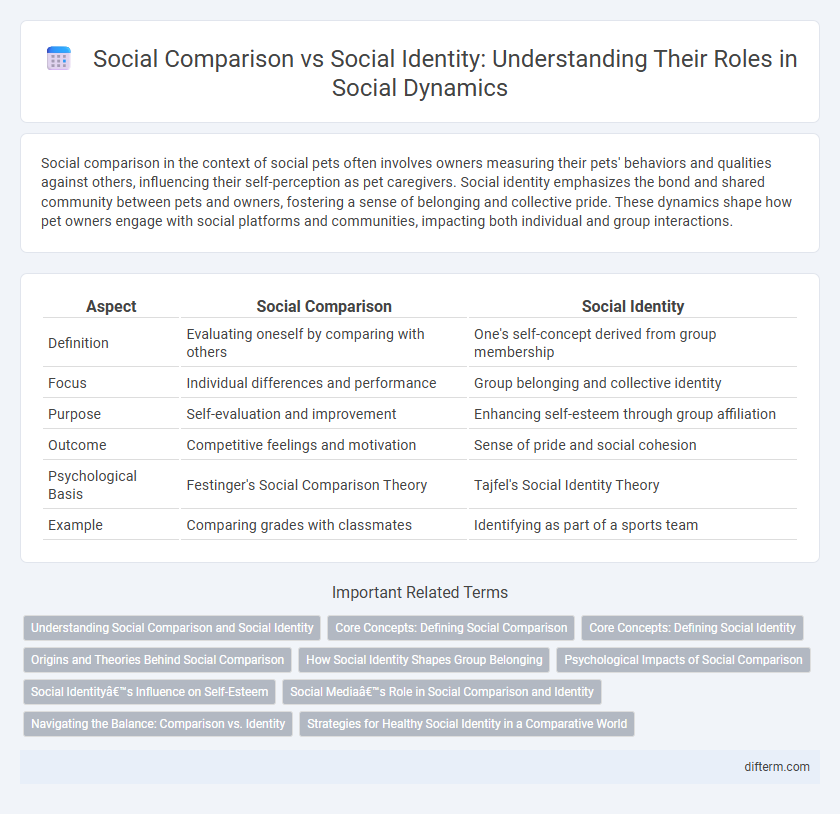Social comparison in the context of social pets often involves owners measuring their pets' behaviors and qualities against others, influencing their self-perception as pet caregivers. Social identity emphasizes the bond and shared community between pets and owners, fostering a sense of belonging and collective pride. These dynamics shape how pet owners engage with social platforms and communities, impacting both individual and group interactions.
Table of Comparison
| Aspect | Social Comparison | Social Identity |
|---|---|---|
| Definition | Evaluating oneself by comparing with others | One's self-concept derived from group membership |
| Focus | Individual differences and performance | Group belonging and collective identity |
| Purpose | Self-evaluation and improvement | Enhancing self-esteem through group affiliation |
| Outcome | Competitive feelings and motivation | Sense of pride and social cohesion |
| Psychological Basis | Festinger's Social Comparison Theory | Tajfel's Social Identity Theory |
| Example | Comparing grades with classmates | Identifying as part of a sports team |
Understanding Social Comparison and Social Identity
Social comparison involves evaluating oneself by measuring against others to assess abilities and opinions, often influencing self-esteem and motivation. Social identity refers to a person's sense of belonging to particular groups, shaping behavior, attitudes, and self-concept based on group membership. Understanding the interplay between social comparison and social identity reveals how individuals navigate social environments to maintain positive self-perception and group cohesion.
Core Concepts: Defining Social Comparison
Social comparison involves evaluating oneself by measuring personal attributes against those of others, serving as a key mechanism for self-assessment and motivation. This process contrasts with social identity, which centers on group membership and collective self-concept rather than individual evaluation. Understanding social comparison requires analyzing dimensions like upward, downward, and lateral comparisons, each influencing self-esteem and behavior differently.
Core Concepts: Defining Social Identity
Social identity is defined as an individual's self-concept derived from perceived membership in social groups, emphasizing group norms, values, and shared characteristics. Social comparison involves evaluating oneself against others to determine social standing or self-worth, often influencing behaviors and attitudes within group contexts. Understanding social identity core concepts highlights how group affiliations shape individual perceptions and drive social comparison processes.
Origins and Theories Behind Social Comparison
Social comparison, first conceptualized by Leon Festinger in 1954, arises from the innate human drive to evaluate oneself through the lens of others, facilitating self-assessment and motivation. This theory posits that individuals compare their abilities and opinions with those of peers to reduce uncertainty and enhance self-understanding. In contrast, social identity theory, developed by Henri Tajfel and John Turner, emphasizes group membership and intergroup dynamics, highlighting how social categorization and identification shape self-concept.
How Social Identity Shapes Group Belonging
Social identity fundamentally shapes group belonging by reinforcing shared values, norms, and a collective sense of self among members. Unlike social comparison, which evaluates individual status relative to others, social identity emphasizes affiliation and emotional attachment to a group. This strong identification boosts group cohesion, fosters loyalty, and influences behavior aligned with group goals and social norms.
Psychological Impacts of Social Comparison
Social comparison often triggers feelings of inadequacy, anxiety, and lowered self-esteem as individuals evaluate themselves against others' achievements or appearances. This process can lead to negative psychological impacts such as depression and increased stress, stemming from unrealistic standards and constant self-judgment. In contrast, social identity provides a sense of belonging and self-worth by aligning with group membership, which can buffer against the harmful effects of social comparison.
Social Identity’s Influence on Self-Esteem
Social identity significantly shapes self-esteem by linking individuals to groups that provide a sense of belonging and validation, reinforcing positive self-concepts through collective achievements and shared values. This group affiliation often buffers against negative self-assessments caused by adverse social comparisons, fostering emotional resilience. Consequently, strong social identity enhances psychological well-being by grounding self-worth in communal success rather than individual metrics alone.
Social Media’s Role in Social Comparison and Identity
Social media platforms amplify social comparison by constantly exposing users to curated, idealized portrayals of others' lives, which influences self-esteem and identity formation. Algorithms prioritize content that triggers engagement, often highlighting differences that intensify comparisons and affect users' social identity construction. Understanding this dynamic is crucial for addressing the psychological impacts of social media on individual and group identity development.
Navigating the Balance: Comparison vs. Identity
Navigating the balance between social comparison and social identity involves understanding how individuals assess their self-worth through others while maintaining a stable sense of belonging. Social comparison often drives behaviors by highlighting differences, whereas social identity fosters group cohesion and shared values, both influencing psychological well-being. Mastery of this balance enhances personal growth and strengthens social connections within diverse communities.
Strategies for Healthy Social Identity in a Comparative World
Maintaining a healthy social identity in a world driven by social comparison involves emphasizing self-acceptance and authentic group affiliations over external validation. Practicing mindfulness and focusing on intrinsic values reduce the negative impact of upward comparisons that can harm self-esteem. Building supportive social networks that celebrate individual uniqueness fosters resilience and promotes a balanced sense of belonging.
social comparison vs social identity Infographic

 difterm.com
difterm.com